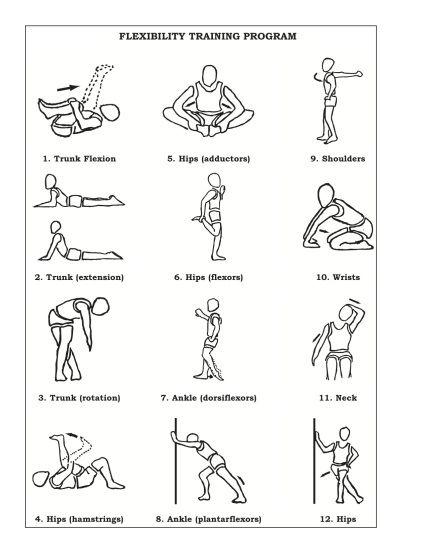In today’s fast-paced world, maintaining optimal mobility is key to staying active, preventing injuries, and enhancing overall quality of life. Whether you’re an athlete aiming to improve performance or someone simply looking to move more freely through daily activities, an effective flexibility training program can make all the difference. In this article,we’ll explore how targeted flexibility exercises can boost your range of motion,support joint health,and contribute to long-term physical well-being. Let’s dive into the essential strategies to help you unlock your body’s full potential and move with greater ease.
Table of Contents
- Benefits of Enhanced Mobility for Everyday Life and Athletic Performance
- Key Components of a Comprehensive Flexibility Training Program
- Techniques and exercises to Improve Flexibility Safely and Effectively
- Creating a Consistent Routine to Maximize Long-Term Mobility Gains
- Closing Remarks
Benefits of Enhanced Mobility for Everyday Life and athletic Performance
Incorporating enhanced mobility into your daily routine can significantly transform the way you move, reducing stiffness and discomfort while increasing your range of motion. Improved flexibility not only supports joints and muscles but also helps prevent injuries caused by repetitive strain or improper posture. By embracing mobility exercises, you can enjoy benefits such as:
- Greater ease in daily activities like bending, reaching, and twisting without pain
- Improved circulation that accelerates muscle recovery and reduces fatigue
- Enhanced balance and coordination, lowering the risk of falls and accidents
For athletes, this boost in mobility is often the missing link between good performance and peak output. Flexibility training complements strength and endurance work by optimizing movement patterns and allowing muscles to work more efficiently. This translates into quicker reaction times, increased power output, and smoother transitions during dynamic movements.Key advantages for athletic performance include:
- Enhanced muscle elasticity that prevents strains and tears
- Improved joint health which supports longevity in sporting careers
- Faster muscle activation and recovery leading to consistent performance gains
Key components of a Comprehensive Flexibility Training Program
Creating a well-rounded flexibility training program involves multiple elements that target various muscle groups and movement patterns.First and foremost, incorporating dynamic stretching exercises enhances blood flow and prepares muscles for activity, reducing the risk of injury. Complementing this with static stretching after workouts promotes muscle relaxation and helps elongate muscle fibers over time. It’s also essential to include myofascial release techniques, such as foam rolling, which aids in breaking down knots and adhesions within the connective tissue, improving overall muscle pliability.
Additionally, the program should focus on progressive overload and consistency to yield lasting improvements. Integrating joint mobility drills ensures that the full range of motion is targeted, which is crucial for daily activities and athletic performance alike. Don’t overlook the meaning of proper breathing techniques to enhance muscle relaxation during stretching, increasing the effectiveness of each session. By blending thes components thoughtfully, you’ll build a solid foundation that not only boosts flexibility but also supports long-term joint health and functional movement.
techniques and Exercises to Improve Flexibility Safely and Effectively
Incorporating a variety of techniques into your routine can significantly enhance your flexibility without risking injury. Dynamic stretching, performed before workouts, is excellent for increasing blood flow and loosening muscles. Movements such as leg swings, arm circles, and hip openers prepare your body by mimicking the activity ahead. Post-exercise, static stretching—where you hold a stretch for 20 to 30 seconds—helps lengthen muscles and improve suppleness over time. Don’t underestimate the power of PNF (Proprioceptive Neuromuscular Facilitation) stretching, a method that involves alternating between contracting and relaxing muscles to achieve deeper stretches effectively and safely.
Consistency and mindful technique are crucial to gaining flexibility benefits while minimizing strain. Aim for gentle, gradual progression, avoiding any bouncing or forced movements that can cause muscle tears. Complement your stretches with exercises like yoga or Pilates to strengthen both the muscles and connective tissues supporting your joints. Remember to focus on proper breathing patterns during stretches, as this promotes relaxation and can increase your range of motion. Incorporate these strategies routinely, and you’ll notice enhanced mobility, reduced muscle tension, and a greater ease in everyday movements.
Creating a Consistent Routine to Maximize Long-Term Mobility Gains
Consistency is the cornerstone of achieving lasting improvements in mobility. By integrating your flexibility exercises into a daily or weekly schedule, you create a habit that the body can adapt to effectively. Consider setting aside specific times—morning or evening—to dedicate to your stretching routine. This regularity not only boosts physical gains but also reinforces mental commitment, making it easier to stay motivated over the long haul.
To optimize your routine, focus on variety and progression. Incorporate stretches targeting different muscle groups, and gradually increase the intensity or duration as your body grows more flexible. A typical session might include:
- Dynamic stretches to warm up muscles and prepare them for movement
- Static holds to deeply elongate muscle fibers
- Myofascial release techniques using tools like foam rollers
Adopting this structured yet adaptable approach ensures your flexibility training remains effective, enjoyable, and aligned with your mobility goals.
Closing Remarks
Incorporating a well-structured flexibility training program into your routine is a powerful step toward enhancing your overall mobility and improving quality of life. By prioritizing consistent stretching and targeted exercises, you not only reduce the risk of injury but also unlock greater ease of movement in daily activities and athletic pursuits.Remember, the key to lasting benefits lies in patience and regular practice—progress might potentially be gradual, but the rewards are well worth the effort. Start today, stay committed, and watch your mobility transform, empowering you to move with confidence and freedom every day.

